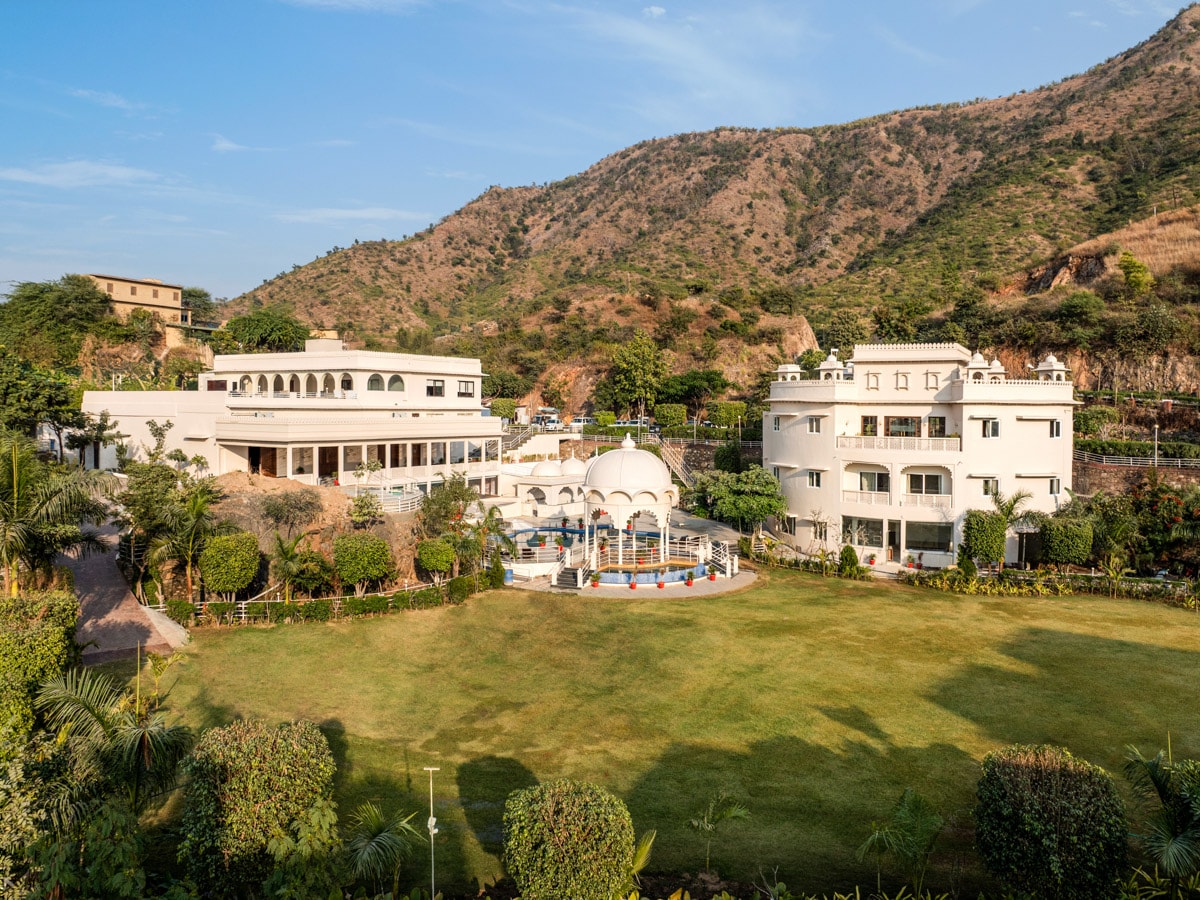 Sayaji Resort & Spa spans 16 acres, seamlessly integrating with its natural surroundings, offering sweeping views of the Aravalli mountains
Sayaji Resort & Spa spans 16 acres, seamlessly integrating with its natural surroundings, offering sweeping views of the Aravalli mountains
Image: Courtesy Sayaji Hotels
While Udaipur’s lakes dazzle in Rajasthan’s crown, its winding streets from 1559, singing stories of maharajas and courtesans, of artisans who once sculpted architectural sensations and their descendants who still breathe life into tradition—painting on canvas, and even water, or creating intricate inlay work from bone and glass—a different magic unfolds just 20 kilometres away. Amid the weathered folds of the Aravalli hills—some of Earth’s oldest mountains—time forgets to tick forward. In this setting, Sayaji Resorts & Spa is the newest addition to Udaipur’s hospitality landscape, offering sweeping views of the Aravalli mountains from each of its 50 Mewar-themed rooms and suites—carrying forward the city’s legacy through curated art, heritage, wellness, and royal dining experience.
“Set against the breathtaking Aravalli Hills, the resort spans 16 acres, seamlessly integrating its natural surroundings. This property marks a significant milestone as the first flagship resort under the Sayaji brand in Udaipur, setting a benchmark for future developments. Architectural elements like Jharokhas, Chhatris, and domes were introduced to complement a clean, uncluttered aesthetic, enhanced by thoughtful lighting. With plans for 40 more rooms and 58 villa-style accommodations around a man-made lagoon, the vision is to redefine luxury in the region,” says Sumera Dhanani, regional director, Sayaji Hotels, to Forbes India.
The resort blends Rajasthani heritage with modern design throughout—incorporating leaf-shaped drawings, cotton-silk and mashru-silk upholstery. In the Aravalli Suite, traditional elements such as marble inlay and fabric-printed floral headboards complement contemporary bed structures. Taking an innovative step further with the sustainability efforts, apart from using glass bottles—Sayaji Udaipur has also introduced textile recycling where they will now transform discarded clothing into fabric flower bouquets, creating permanent room decorations that reduce waste while enhancing the environment.
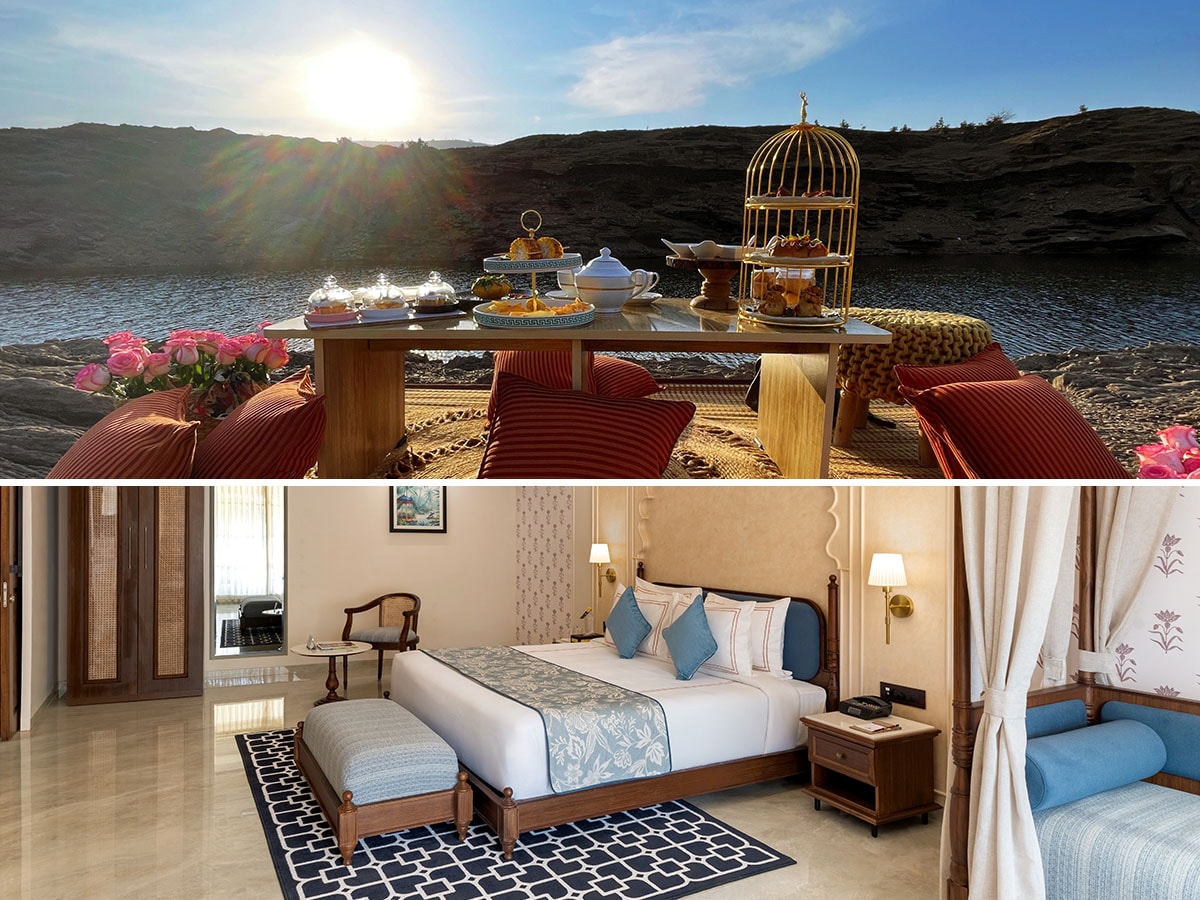 Picnic by the Alsigarh lake(top). Traditional elements such as marble inlay and fabric-printed floral headboards complement contemporary bed structures in the Aravalli Suite Image: (top)Veidehi Gite; Room:Courtesy Sayaji Hotels
Picnic by the Alsigarh lake(top). Traditional elements such as marble inlay and fabric-printed floral headboards complement contemporary bed structures in the Aravalli Suite Image: (top)Veidehi Gite; Room:Courtesy Sayaji Hotels
Meanwhile, eco-friendly Chatai ceilings, Rattan chairs, and mosaic fan floor patterns in the private dining area and Taraksh restaurant echo the aesthetics of Rajasthan’s villages. The soulful strains of the Ravanhatha, played by folk musician (the Bhopa) Suresh, on an ancient bowed instrument, crafted from bamboo, coconut shell, goat membrane, and horsehair strings, brings Rajasthan’s heritage to life at the reception.
Dhanani emphasises the resort’s commitment to integrating local artistry into its design. “Our next step is to collaborate with local artists to infuse the property with authentic Rajasthani craftsmanship. Rather than outsourcing to event planners, the focus is on working directly with artisans from local markets. “They may not be highly polished, but their deep-rooted knowledge of the craft is what truly matters. We want guests to experience art in its most authentic form,” she says. The initiative has already begun with pottery and lak ka churri (lacquered bangles), with plans to expand into other traditional art forms, further celebrating the region’s rich cultural heritage.
As efforts are underway to integrate Rajasthan’s artistic heritage into the resort’s design, Debosmita Kapse, senior marketing and communications manager, shares that they are procuring kamlo ki pichwai, a contemporary adaptation of the Nathdwara’s traditional pichwai art. Unlike conventional pichwai, which is exclusively painted, this modern version can be embroidered and painted on fabric. “Pichwais are traditionally centered on deities, as Udaipur’s royal family regarded Eklingji as the true ruler, with the king serving merely as his representative,” Kapse explains. “Earlier, all pichwais were created in honour of Eklingji and Shrinathji in the havelis.”
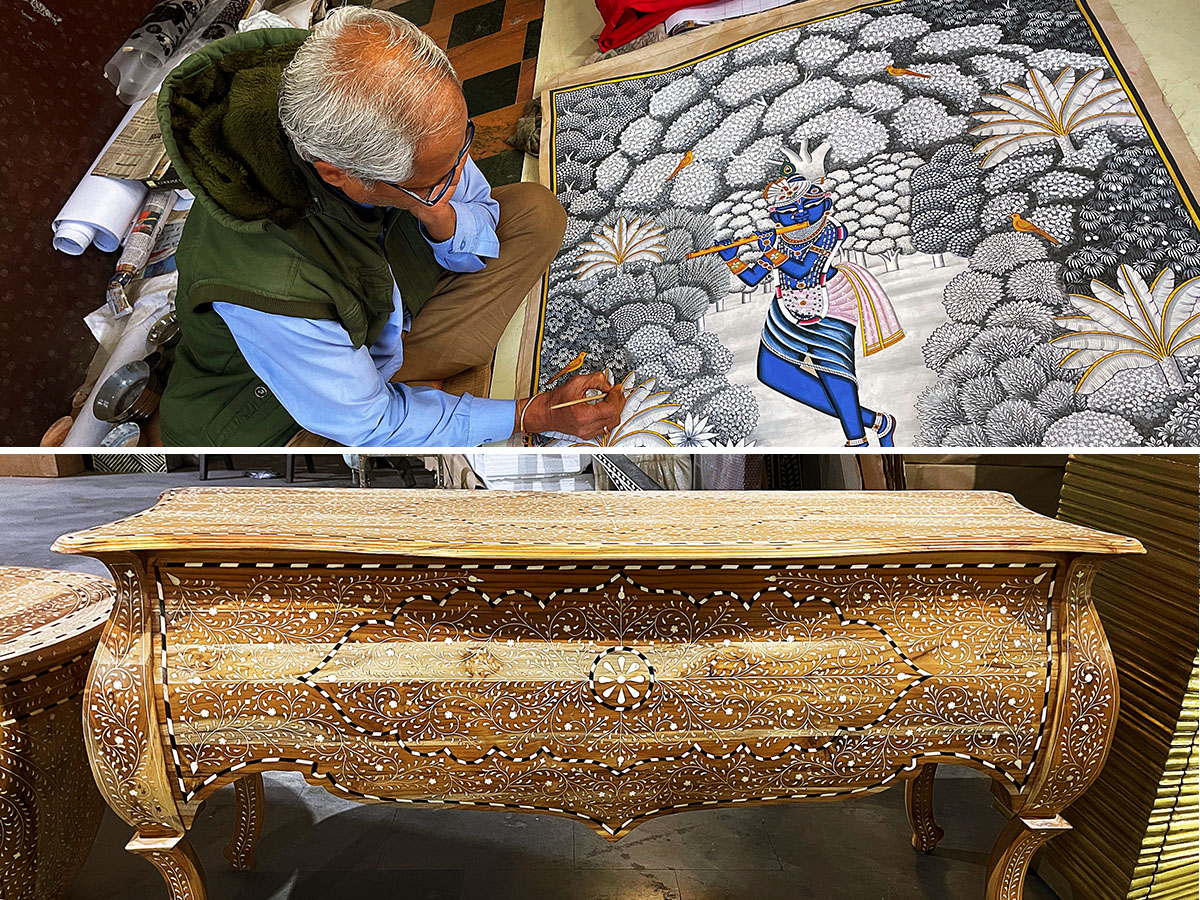 Pichwai artist Arun Sharma painstakingly applies natural pigments, taking weeks or months on Nathdwara’s traditional art (top). A luxury coffee table with floral motifs crafted at a bone inlay workshop.
Pichwai artist Arun Sharma painstakingly applies natural pigments, taking weeks or months on Nathdwara’s traditional art (top). A luxury coffee table with floral motifs crafted at a bone inlay workshop.
Image: Veidehi Gite
As I sat down with pichwai artist Arun Sharma in the heart of old Udaipur, his words peeled back the traditional layers of this revered art form, “Pichwais are inspired by Lord Krishna’s life—his leelas and the festivals that celebrate him, such as Annakut, Gopashtami, Holi, and Sharad Purnima. These themes form the essence of my paintings.” Tracing the origins of this elaborate art, Sharma delved into its past. “In earlier times, pichwai paintings were exclusively created for temples, painted on cloth as a form of devotion rather than decoration. They weren’t widely known outside religious circles,” he said. However, history played a crucial role in their evolution. “When Aurangzeb’s reign saw the destruction of temples, the worshippers of Shrinathji—an incarnation of Krishna—migrated to Mewar. To preserve the deity’s stories, they continued painting pichwais. The name itself comes from ‘pichh,’ meaning ‘behind,’ as these paintings were placed behind the idol in temple sanctums.”
Also read: Desert’s paradox: When water built an empire
Over time, the devotional artwork found its way into homes. “Today, the art has transcended its original purpose, adorning living rooms and galleries worldwide,” Sharma observed. What makes these paintings enduring is their medium—natural pigments, painstakingly applied over weeks or months. “Traditional pichwais were once crafted with silver dust, while gold foil was introduced later at the request of royalty for temple embellishments,” he shared. “In the oldest paintings, ornaments were originally made from silver Katir, a metal.” At the heart of each pichwai painting lies devotion, interwoven with symbolism. Lotuses signify purity and beauty, peacocks embody romance and eternity, while cows represent sustenance, wealth, and abundance. “A small pichwai takes me at least a week to complete, while larger canvases can take up to two months,” Sharma revealed.
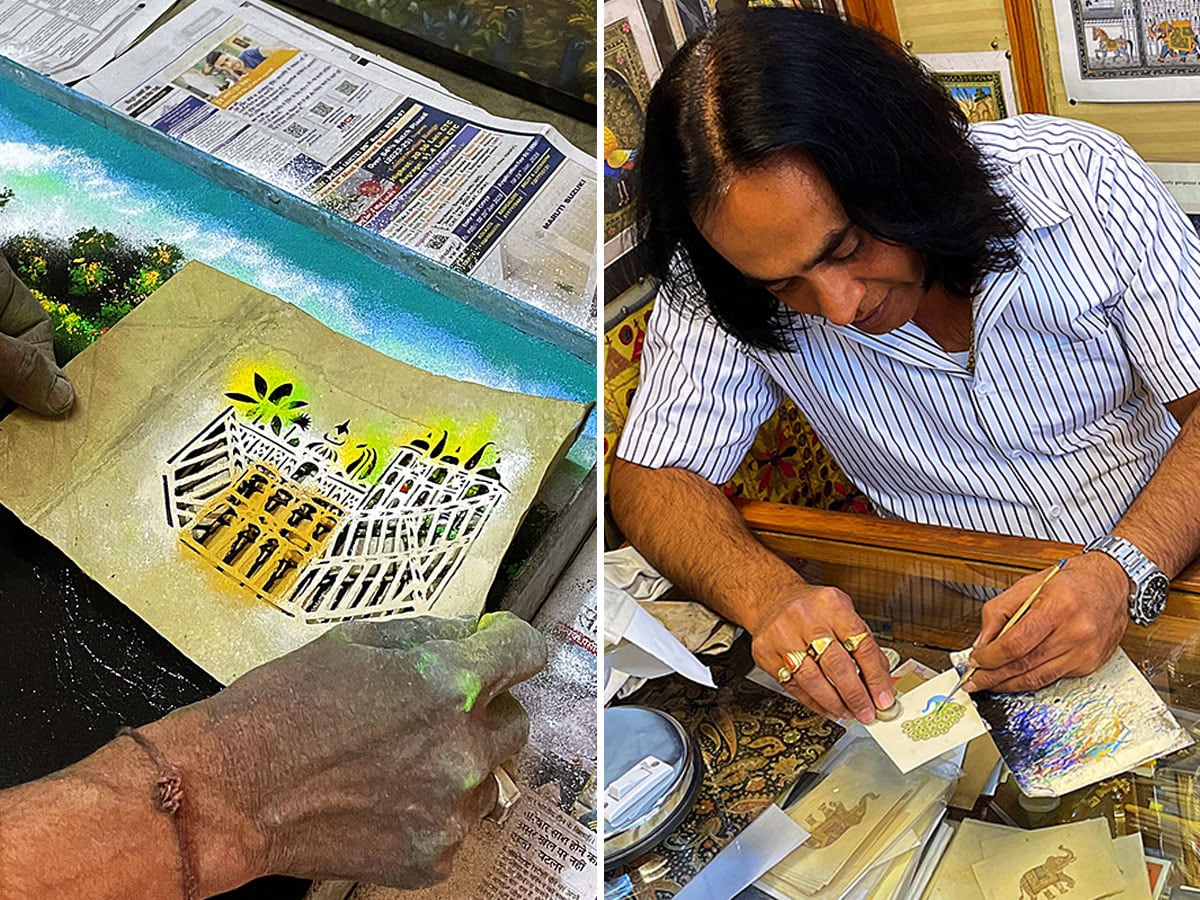 Jal Sanjhi, the ancient practice of painting on water, is a rare art form, kept alive by Rajesh Vaishnav, a 19th-generation artist (left). Soni, a fourth-generation artist, works on a miniature painting, a 17th-century art form often created under a magnifying glass.
Jal Sanjhi, the ancient practice of painting on water, is a rare art form, kept alive by Rajesh Vaishnav, a 19th-generation artist (left). Soni, a fourth-generation artist, works on a miniature painting, a 17th-century art form often created under a magnifying glass.
Image: Veidehi Gite
Just fifteen minutes from Sharma’s workshop in Dholi Magri, I witnessed another rare art form indigenous to Udaipur—jal sanjhi, the ancient practice of painting on water. This craft, devoted to Lord Krishna and Udaipur’s grand palace scenes, is kept alive by Rajesh Vaishnav, a 19th-generation artist whose family has safeguarded the tradition for over 500 years. As Vaishnav prepared for a live demonstration, he shared a remarkable detail. “Central to this art are the stencils, and I’m still using the ones my ancestors created 400 years ago,” he revealed, carefully placing natural pigments onto the water’s surface. The natural colours, remain afloat for nearly 48 hours, creating ephemeral masterpieces that dissolve with time. While some of his disciples are experimenting with contemporary interpretations of painting on water, Vaishnav’s unwavering commitment to tradition sets him apart. “The depth and generational legacy I bring to this work is what makes me the only artist in India upholding this distinction,” he said with quiet pride.
No visit to Udaipur is truly complete without exploring the iconic City Palace and the bustling bazaars that surround it. Here, the streets burst with colour—offering handcrafted leather accessories, traditional textiles, and exquisite jewellery adorned with precious and semi-precious stones. Among these treasures, one stands out: Miniature painting, a 17th-century art form that continues to flourish in Udaipur’s old quarters. For an authentic glimpse into this delicate craft, Sanju Art is a must-visit. Soni, a fourth-generation miniature artist, masterfully brings the tradition to life, working in both monochrome and luminous colours. His intricate designs—often created under a magnifying glass—offer a rare, up-close look at an art form on the brink of extinction.
Back at the resort, evenings are for cultural ruminations. A ‘kalbelia’ dance, wherein resplendently attired Rajasthani women from a snake charming tribe, pirouetting with matkas (pots) on their heads, consummate grace to the pulsating cadences of indigenous folk melodies, and for a change of pace, a picnic by the nearby Alsigarh Lake accompanied by the soothing notes of a live santoor performance, blends artistic expression with natural beauty. Your day at the resort would typically begin with horse riding and rabbit feeding, and as it winds down, a therapeutic spa massage offers the perfect retreat.
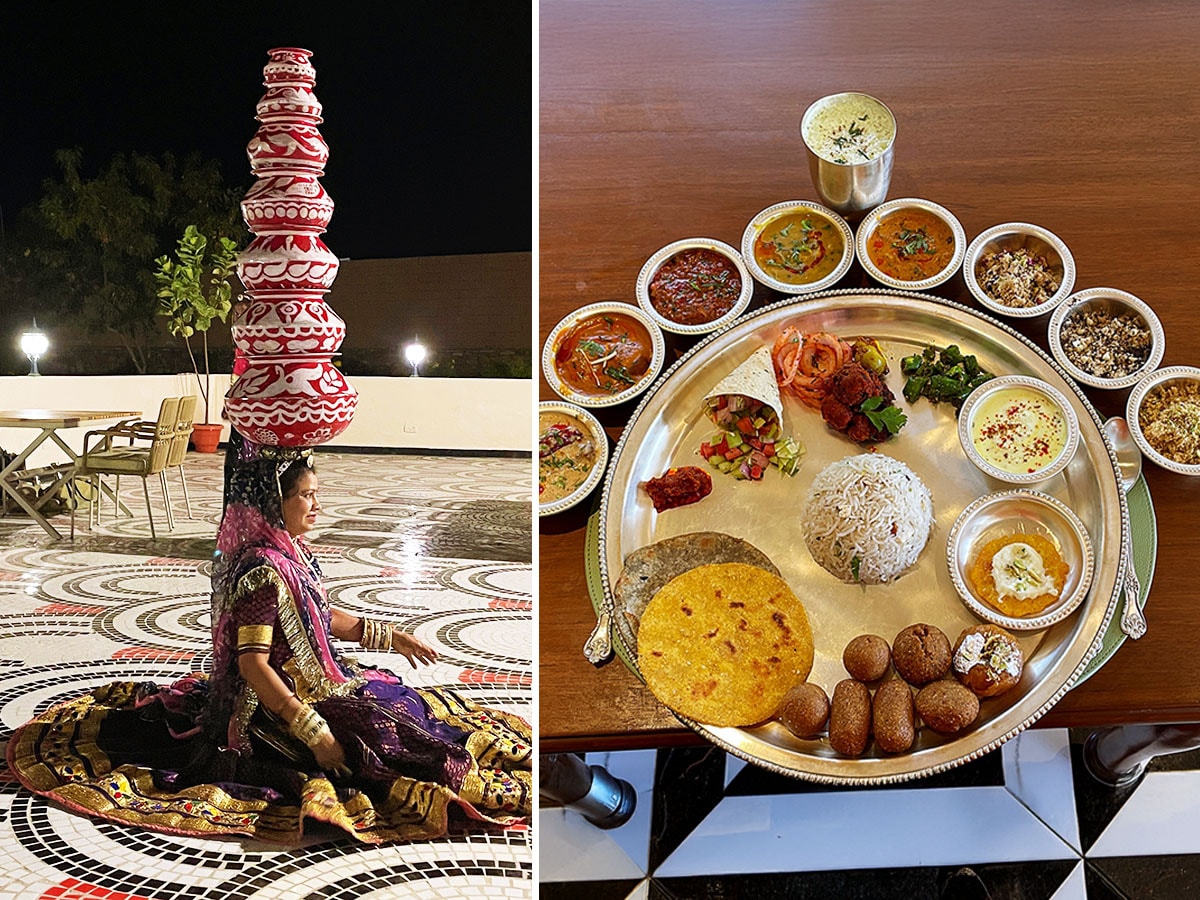 A Rajasthani woman from a snake charming tribe performs ‘Kalbelia’ dance with pots on her head (left). The royal Rajasthani Thali, an opulent spread that exemplifies the legendary hospitality of Mewar.
A Rajasthani woman from a snake charming tribe performs ‘Kalbelia’ dance with pots on her head (left). The royal Rajasthani Thali, an opulent spread that exemplifies the legendary hospitality of Mewar.
Image: Veidehi Gite
Following the cherished Rajasthani tradition, Sayaji Resorts & Spa places culinary excellence at the centre of every guest’s stay. The kitchen celebrates the rhythm of seasons, bringing forth iconic dishes like the laal (red) and the safed (white) maas, and the distinctive variations of ker sangri in winter months. Regional specialties curated by executive chef Rajendra Singh tempt with dishes like the stuffed baatis, murgh mathania ka shorba, Jodhpuri gatta curry, gulab jamun ki sabzi, and mandawa ka pulao, alongside desserts like gud laapsi, malai ghevar and khajur gud ke baked rasgulle. While the restaurant ventures into international territory with indulgent fusion dishes—the crown jewel remains the local fare and the piece de resistance is the royal Rajasthani Thali, an opulent spread that, when accompanied by fine wines, exemplifies the legendary hospitality of Mewar.
As my time in Udaipur drew to a close, a final stop at a bone inlay workshop felt like a fitting finale—a fascinating counterpoint to the marble inlay craftsmanship I had admired in my suite. Luxury Handicrafts owned by young entrepreneurs Chirag Jain and Tej Singh Ahluwati, allowed me to trace the evolution of bone inlay art, once crafted from camel bones during royal times but now ethically sourced from buffalo bones, as camels—Rajasthan’s state animal—are protected. The meticulous, eight-to-ten-step process remains unchanged, requiring weeks of skilled craftsmanship. “From sun-drying the raw bones to cutting, grinding, colouring, and polishing, everything is done by hand. Even a small coffee table takes 15 to 20 days and a team of two to three artisans to complete,” they explained. Prices range from $500 for smaller pieces to $100,000 for elaborate designs, with floral motifs dominating their collections, though custom designs are welcomed.
Standing amidst artisans carving delicate patterns by hand, I realized that Udaipur’s artistic legacy is not just preserved—it thrives. This glimpse into a centuries-old craft, still alive in the hands of its makers, was the perfect finale to my journey—a reminder that in Udaipur, tradition is not a relic of the past but a living, evolving masterpiece.
